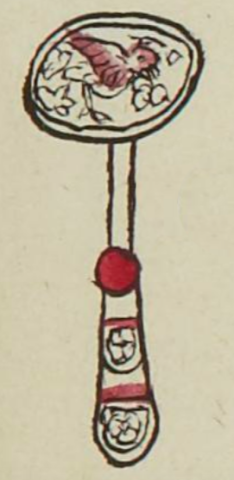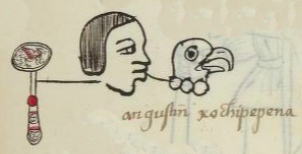xochimaqui (MH529r)
Here, this simplex glyph seems stand for the occupation of producing and providing flowers (xochimaqui, including the preparation of flower arrangements. The glyph in focus here is not glossed, so this could be a huacaxochitl (Juan José Batalla Rosado, personal communication, January 4, 2023). It shows a vertical device that would be hand held. At the base of the handle are two separate, quincunx-shaped flowers enclosed in circles. Red horizontal lines separate them. Above this section is a larger red circle. The part at the top is like a disc filled with flowers and a small red bird sitting on top. The result is something of a device, perhaps for holding while dancing.
Stephanie Wood
Batalla Rosado prefers the reading of xochimaqui (over xochimanqui) for this occupational glyph on folio 529 recto of the Matrícula de Huexotzinco. He reminds us that some references to xochimaqui in the MH are Nahua surnames and some are occupations. He also says it could be a huacaxochi. (Personal communication from Batalla Rosado, January 4, 2023.) Both terms have been studied by Pedro Carrasco (in his introduction to a volume by H. J. Prem, 1974, p. 12).
This flower device that definitely represents an occupation in this case, being to the left of a person with a different hieroglyphic personal name (Cozcacuauh), could have been carried and made as an offering during religious activities. Clavijero (The History of Mexico, 1787) says that during the month of April the xochimanque (flower dealers) would celebrate their deity, Coatlicue, making offerings to her of “curiously woven” flower garlands. The bird in this glyph image is not mentioned by Clavijero. A huacaxochi that is attested in the MH (f. 641r.) does have a horizontal arrangement of flowers supported by what appears to be a woven petlatl.
The -ma- versus -man- in the middle of this word might depend upon whether the observer sees maca (to give) or mani (to have the quality of) as the intended verb.
Stephanie Wood
1560
Jeff Haskett-Wood
flowers, flores, hand-held, hands, manos, devices, aparatos, birds, pájaros

xochimanqui, florist, https://nahuatl.wired-humanities.org/content/xochimanqui
xochi(tl), flowers, https://nahuatl.wired-humanities.org/content/xochitl
ma(itl), hand or arm, https://nahuatl.wired-humanities.org/content/maitl
maca, to give/offer, https://nahuatl.wired-humanities.org/content/maca
-qui, one who does that thing, https://nahuatl.wired-humanities.org/content/qui-1
florista o aquel que hace ramos de flores
Juan José Batalla Rosado
Matrícula de Huexotzinco, folio 529r, https://www.loc.gov/resource/gdcwdl.wdl_15282/?sp=137&st=image
This manuscript is hosted by the Library of Congress and the World Digital Library; used here with the Creative Commons, “Attribution-NonCommercial-ShareAlike 3.0 License” (CC-BY-NC-SAq 3.0).






